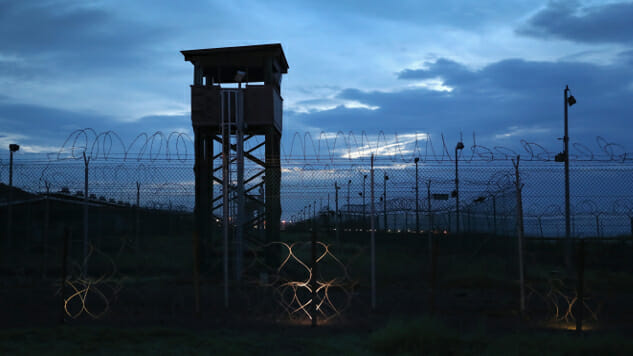Torture, 24 and the Recycled Art of Cruelty
Photo courtesy of Getty
“Does torture work?” Donald Trump claims he asked intelligence officials. “The answer was yes, absolutely.”
During the Bush years, at the height of the wars in Iraq and Afghanistan, FOX had a sensation on its hands with 24, starring Kiefer Sutherland as Counter Terrorist Unit super-agent Jack Bauer. A reboot, 24: Legacy, returns to television after the Super Bowl. The show comes equipped with a new hero-badass, Eric Carter (Corey Hawkins) and a new presidential candidate in Jimmy Smits, involved with the now tired real-time, imminent-terrorist-attack premise and panic.
The subtitle “Legacy” is a curious choice. 24’s real-world impact, its legacy as a piece of highly digestible pop culture entertainment, really does belong in actual history books when it comes to that tricky question of life and art and which one is leading the other around by the ear.
I’ll admit up front, I was a huge fan of the show and remained a viewer well into its exhausted obsolescence. As the country now swerves chaotically into the equivalent of a right-wing 9/11 via the Trump administration, I’d recommend putting Maggie Nelson’s 2011 book, The Art of Cruelty, in your queue. By the time you reach page 11, it reads as Nostradamus-level prescient.
As Nelson puts it, “Art which aims to extinguish the story behind the suffering and focus on the suffering itself partakes in a different, more insidious cruelty—that of depoliticization, of stripping cruelties from their contexts so that they seem pitiable, sensational, or inevitable, rather than contingent, avoidable, or explicable… Such forms of expression can seemingly act as an accomplice, even if unwittingly, to this cynicism, which turns its back on the hard work of ferreting out the reasons why a particular cruelty has occurred, who is responsible for it, who gains from it, and who suffers.”
The premise that seemingly escapist entertainment can actually intertwine and exacerbate policy seems, on the surface, just as specious as the notion that videogames are making children more violent. Yet there is a difference between a mode of entertainment causing aggression and a piece of propaganda creating a template for destructive political decisions.
24 was in the process of making its way back to television just as candidate Donald Trump was promising not only a return to water-boarding and a reinstitution of state-sanctioned torture but also targeting the families of suspected individuals for assassination and “a hell of a lot worse.” For the first time since the notion was dreamt up, an American presidential candidate ran on a platform promising war crimes.
During 24’s first run, each season was gleefully punctuated with Jack Bauer torturing mostly Arab men (although women and white people were by no means safe). The lesson of 24 was ground into the heads of viewers over and over: Jack Bauer was always correct to escalate and expand his brutality in order to save American lives from terrorists. He shot people, broke digits, cut off their heads, electrocuted them, injected a magic torture serum, and a hell of a lot worse. In the worldview of 24, any character squeamish about “getting their hands dirty” simply didn’t understand the stakes or the costs. The show egged on a hyper-masculine fantasy where brutality is the ultimate currency, where those reluctant to exercise efficient savagery are ultimately unmasked as cowards and punished appropriately.
This ethos—already well-established in cop shows where breaking the rules, infringing on people’s civil liberties, ignoring their constitutional rights, scoffing at the notion of a lawyer, and yes, beating the truth out of them—took a massive leap forward during 24’s most popular years. Suddenly, you saw the same reasoning take total primacy in most action films or television shows.
-

-

-

-

-

-

-

-

-

-

-

-

-

-

-

-

-

-

-

-

-

-

-

-

-

-

-

-

-

-

-

-

-

-

-

-

-

-

-

-








































